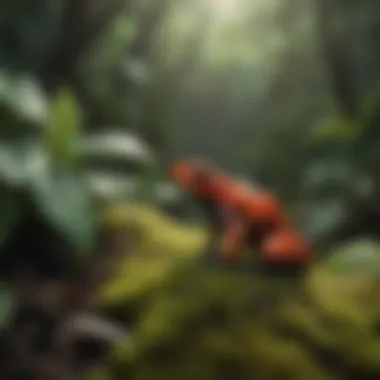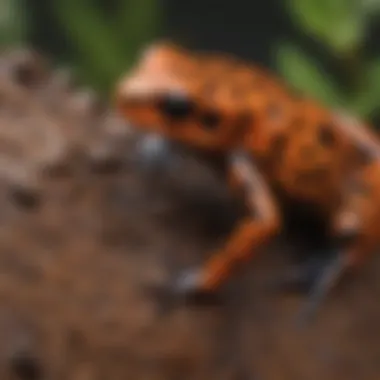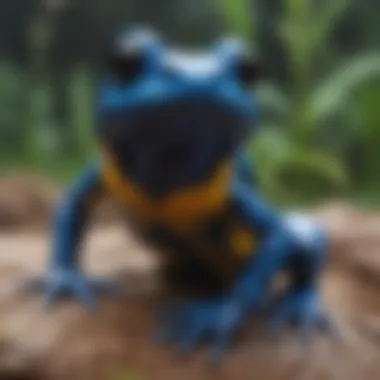Understanding Poison Dart Frogs as Pets: Care and Insights


Intro
Poison dart frogs have become increasingly popular as pets due to their vivid colors and intriguing behaviors. Nonetheless, these amphibians come with unique challenges that require proper knowledge and commitment from their owners. Understanding the intricacies of caring for poison dart frogs is essential for ensuring they thrive in a domestic environment. This article will offer a comprehensive look into the needs and responsibilities associated with maintaining these fascinating creatures.
Understanding Your Pet
Pet Behavior Basics
Gaining a deeper understanding of poison dart frog behavior is crucial for any owner. These frogs are primarily active during the day, exhibiting behaviors that are typical of tropical species. They tend to inhabit humid environments, showing a preference for moisture-rich areas where they can express their natural behaviors. Owners can observe these frogs engaging in activities such as climbing and exploring their habitat.
Common Breed Characteristics
Different species of poison dart frogs exhibit various characteristics. Varieties like the Dendrobates tinctorius are known for their striking color patterns and larger size compared to other species. Understanding these traits helps owners tailor their care accordingly. The vibrant colors often reflect their toxicity in the wild, but those kept in captivity may lose this trait due to diet and environment.
Species-Specific Needs
Each species has distinct requirements, particularly in terms of habitat. It is essential to research specific needs based on the frog type you choose. Key aspects include temperature, humidity, and space. For instance, maintaining a terrarium that replicates their natural habitat is vital. Such conditions ensure both physical health and behavioral well-being.
Pet Care and Maintenance
Feeding Guidelines
Feeding poison dart frogs requires knowledge of their dietary preferences. In captivity, these frogs typically eat small insects like fruit flies, pinhead crickets, and springtails. A varied diet is crucial for their health, and owners должно carefully measure feeding to prevent overfeeding.
Grooming Essentials
While poison dart frogs do not require grooming in the traditional sense, ensuring a clean environment is essential. Regular maintenance of the terrarium helps prevent mold and diseases, making it a safer space for the frogs to thrive.
Hygiene Practices
Maintaining proper hygiene is fundamental when caring for poison dart frogs. Regular cleaning of their habitat and monitoring for any changes in their appearance or behavior can help in early detection of potential health issues. Owners should understand the importance of water quality and remove waste promptly to maintain a healthy living environment.
Health and Wellness
Routine Vet Check-ups
Regular veterinary check-ups provide peace of mind for owners. Qualified exotic veterinarians should be consulted at least once a year to monitor overall health and address any concerns. Owners should keep track of any behavior or signs of illness between visits.
Vaccination Needs
Poison dart frogs typically do not need vaccinations as conventional pets do. However, discussing any preventative treatments or medications with a veterinarian is advisable, especially when introducing a new frog into an existing collection.
Recognizing Signs of Illness
It is crucial for owners to be able to identify illness signs. Common indicators include lethargy, lack of appetite, or skin abnormalities. Prompt attention to these signs can significantly increase the chances of recovery.
Enrichment and Activities
Indoor vs.
Outdoor Activities
Although poison dart frogs are primarily indoor pets, they can have enriching experiences in a controlled outdoor environment. Owners should ensure outdoor areas are free from potential hazards like pesticides or pollutants.
Interactive Toys and Games
These frogs benefit from environmental enrichment within their terrarium. Incorporating items like plants and climbable structures provides mental stimulation. Discussing ideas with fellow enthusiasts can yield innovative methods for engaging these frogs.
Socialization Opportunities
Interactions should be limited, as poison dart frogs are not social creatures. However, observing them in groups in a controlled environment can showcase their natural behavior. Understanding how to socialize without stressing them is essential for their well-being.
Proper care requires understanding both the behavioral and environmental needs of poison dart frogs.


By comprehensively addressing the facts about poison dart frogs, prospective owners can prepare better for their integration into domestic life while respecting their unique characteristics. The interest surrounding these vibrant amphibians should be tempered with respect for their complexity and individual requirements.
Prologue to Poison Dart Frogs
Poison dart frogs are fascinating creatures, often captivating both researchers and pet enthusiasts alike. Their vibrant colors and unique behaviors attract attention, making them an appealing choice for those interested in exotic pets. However, before considering them as pets, it is essential to understand their specific needs and traits.
Overview of Species
There are over 200 species of poison dart frogs, each displaying distinct color patterns and adaptations. Most of these frogs are native to tropical rainforests in Central and South America. A few notable species include the blue poison dart frog, the golden poison dart frog, and the red-eyed tree frog. The toxicity of these frogs varies significantly amongst species. While captive bred poison dart frogs are generally non-toxic, it is essential to recognize their potential hazards if introduced into an unsuitable environment.
The small size of these amphibians ranges from 0.5 to 2 inches. Their bright coloration serves a significant purpose—acting as a warning to predators about their toxicity. Color also plays a role in communication and mating displays. The intricate mating rituals and vocalizations are relevant to their natural behavior, which will be discussed further.
Habitat and Natural Behavior
Understanding the natural habitat of poison dart frogs is crucial for creating an environment that meets their needs in captivity. In the wild, these frogs thrive in humid, densely vegetated areas close to water sources. They are often found hiding under leaves or logs, where they can maintain moisture and avoid predators.
In terms of behavior, poison dart frogs are diurnal, which means they are active during the day. They have fascinating social structures, often forming small groups, which can be beneficial in captivity as they may exhibit less stress when housed with other frogs of the same species. Their diet in the wild primarily consists of small insects, including ants and termites. This diet significantly influences their health and coloration.
Creating a similar environment in captivity is essential, as it supports their natural behaviors and overall well-being.
Understanding the biological and behavioral aspects of poison dart frogs is vital. This knowledge will ensure that potential pet owners can provide an optimal living situation that enhances these frogs' quality of life.
Legal Considerations
Understanding the legal framework surrounding the ownership of poison dart frogs is crucial for potential pet owners. Comprehending regulations and ethical considerations helps ensure the well-being of these amphibians and promotes responsible pet ownership.
Regulations on Ownership
Before acquiring poison dart frogs, it is essential to research local laws and regulations. Various countries and regions have specific rules regarding the ownership of exotic pets, including poison dart frogs. In some places, certain species may be protected under wildlife conservation laws, meaning that owning them could be illegal or require special permits. For example, in the United States, the importation and sale of certain poison dart frog species can be regulated by the U.S. Fish and Wildlife Service.
Considerations regarding legality often include:
- Permits: Some jurisdictions require permits for keeping certain species, particularly those that are considered endangered.
- Species Restrictions: Certain species might be banned from private ownership to protect their populations in the wild.
- Trade Regulations: International laws, such as the Convention on International Trade in Endangered Species of Wild Fauna and Flora (CITES), may also apply to the sale and ownership of these frogs, affecting how and where they can be purchased.
Understanding these regulations not only protects potential owners from legal repercussions but also helps to support conservation efforts.
Ethics of Captivity
Keeping poison dart frogs as pets raises several ethical questions that potential owners must consider. Ethical ownership emphasizes the responsibility of providing a suitable environment and care that meets the frogs’ specific needs in captivity.
Key points regarding ethics include:
- Welfare: It is vital to ensure that the frogs are provided with an environment that mimics their natural habitat as much as possible. This includes appropriate humidity, temperature, and space.
- Breeding Practices: Responsible breeders should ensure that their practices do not harm wild populations. Purchasing from reputable breeders is crucial to prevent supporting illegal trade.
- Informed Care: Owners should be educated about the complexities of care for poison dart frogs, including their dietary needs and health monitoring.
In ethical pet ownership, the focus should always be on promoting the best interests of the animal.
By navigating the legal landscape and considering the ethical implications, prospective owners can contribute positively to the hobby of keeping poison dart frogs and their conservation in the wild.
Requirements for Keeping Poison Dart Frogs as Pets
Keeping poison dart frogs as pets requires a well-considered approach. These creatures possess unique biological and environmental needs that significantly affect their health and behavior. Understanding these requirements is crucial, as failing to meet them can lead to stress, illness, or even death. A properly designed habitat not only ensures the wellbeing of the frogs but also enhances the owner's experience. Emphasizing the importance of these requirements helps to foster a responsible and enriching pet ownership experience.
Ideal Enclosure Specifications
Creating an ideal enclosure is the first step in successfully keeping poison dart frogs. The enclosure must be spacious enough to allow for natural movements. A minimum of a 20-gallon tank is often recommended for a small group of frogs. This space allows them to explore their environment and exhibit natural behaviors. When setting up the tank, consider the escape-proof design. Poison dart frogs are agile and can easily escape if the enclosure is not properly sealed.
Key factors to include in your enclosure:
- Ventilation: Ensure that the tank is well-ventilated to avoid stagnation of air and moisture.
- Substrate: Use a substrate that retains moisture without causing harm, such as coconut fiber or sphagnum moss.
- Decorations: Incorporate plants, logs, and hideouts to mimic their natural tropical habitat.
Environmental Needs
Poison dart frogs thrive in specific environmental conditions. Their natural habitat is often humid tropical rainforests. Mimicking these conditions is important for their health and lifecycle.
Consider these environmental needs:


- Humidity Levels: Maintain humidity between 60% and 80%. Use misting systems or hygrometers to monitor.
- Cleanliness: Regularly clean the enclosure to prevent mold and harmful bacteria, which can affect the frogs.
Temperature and Humidity Control
The correct temperature range is vital for the overall health of poison dart frogs. Ideal temperatures usually fall between 70°F and 80°F. It is important to avoid temperature fluctuations, as they can lead to stress and health problems.
Humidity control is equally important:
- Install a hygrometer to constantly monitor moisture levels in the enclosure.
- Regular misting can help maintain the right balance, but also consider a drainage system to prevent water buildup.
Lighting Requirements
Proper lighting is essential for the wellbeing of poison dart frogs, influencing their daily activities and behaviors. Natural light cycles should be replicated as much as possible, ensuring frogs receive adequate light during the day and darkness at night.
Guidelines for effective lighting:
- Use UVB lights that emit both heat and UV radiation. This supports metabolism and encourages healthy behavior.
- Lighting should be on for about 12 hours a day and turned off during the night to mimic natural conditions.
It is crucial to ensure that all aspects of the habitat work harmoniously for the frogs to thrive. The focus should be on creating an environment that respects their natural behaviors and needs. Keeping these unique requirements in mind helps potential pet owners provide a safe and enriching habitat, which is essential for successful care of poison dart frogs.
Dietary Needs
Understanding the dietary needs of poison dart frogs is crucial for any pet owner. These small amphibians have specific requirements that must be met to ensure their health and vitality. Their diet directly impacts their overall well-being, energy levels, and even their lifespan. As they are known for their vibrant colors and unique behaviors, providing a suitable diet contributes to appreciating these creatures as part of your household.
Feeding Habits in the Wild
In the wild, poison dart frogs primarily consume a diet rich in insects. They often prey on tiny creatures such as ants, termites, and various small arthropods. The natural foraging behavior allows them to obtain the vital nutrients they need, including proteins, vitamins, and essential fatty acids.
Interestingly, the specific insects they consume can even influence their toxicity levels. For instance, frogs that feed on certain ants retain alkaloids that make them toxic to predators. This natural relationship between diet and toxicity highlights the importance of closely monitoring dietary intake in captivity, to ensure health and safety.
Recommended Diet for Captive Frogs
When keeping poison dart frogs as pets, it is essential to mimic their natural feeding habits. Here are some recommended food items:
- Fruit Flies: Small fruit flies (Drosophila) are a staple. They are easy to digest and rich in nutrition.
- Pinhead Crickets: These provide protein and can be dusted with vitamin supplements.
- Springtails: Another tiny insect that serves as a good food source.
- Other Small Insects: Including small beetles and other soft-bodied insects, though care should be taken to ensure they are appropriate for frogs size.
Feeding should occur every other day, with care taken to adjust the quantity based on the individual frog's size and appetite. Proper feeding ensures that frogs remain vibrant and healthy, while also decreasing stress levels associated with hunger.
Supplements and Nutrition
In addition to a balanced diet, supplements play a critical role in maintaining the nutritional health of poison dart frogs. Here are some considerations:
- Calcium Dust: This is key to prevent metabolic bone disease, a common issue in reptiles and amphibians.
- Multivitamins: A proper multivitamin supplement should be used to ensure frogs receive necessary vitamins that may be lacking in their diet.
It is important to dust the insects with these supplements before feeding the frogs. Too much supplementation can lead to health issues, so it is essential to refer to guidelines provided by professionals or specialized literature. Monitoring the health and weight of your frogs will help in adjusting their diet and supplementation as needed.
Always remember that a proper diet is vital for the well-being of poison dart frogs. Their health depends on the quality of their food and the care of their owners.
Overall, understanding these dietary needs enables frogs to thrive and present their best qualities. A well-fed poison dart frog exhibits not just vibrant colors, but also active behaviors, leading to a rewarding experience for the pet owner.
Handling and Interaction
Handling and interaction with poison dart frogs should be approached with caution. Understanding their unique needs is essential for ensuring that these amphibians thrive in captivity. This section will cover best practices for handling and the signs of stress or discomfort that your pet may exhibit. Learning these facets is not just an act of care; it helps in building a trusting relationship between you and your dart frog.
Best Practices for Handling
When managing poison dart frogs, minimal handling is advisable. These creatures have delicate skin that can absorb harmful substances, including oils from human skin. Here are some recommendations to follow when handling your frog:
- Wash Your Hands: Always wash your hands before and after any contact. This can help to eliminate any chemicals or residues that could be harmful.
- Use a Container: Instead of picking up your frog directly, consider using a small, secure container for transport. This reduces the risk of stress.
- Gentle Touch: If you must hold your frog, do so gently. Avoid squeezing or applying pressure.
- Limit Frequency: Handling should be limited to necessary situations, like cleaning their habitat.
- Observe from a Distance: Often, observing their behavior without interaction can provide insight into their health and well-being.
By adhering to these practices, pet owners can not only protect the health of their poison dart frogs but also contribute to an overall low-stress environment.
Signs of Stress or Discomfort


Recognizing when a poison dart frog is stressed or uncomfortable is crucial. These amphibians can show various signs that may indicate they are not feeling well.
Some common signs include:
- Color Change: Healthy dart frogs usually exhibit vibrant colors. Dullness can signal stress or health issues.
- Hiding: If your frog is spending excessive time hiding, it may be an indication of discomfort or unease.
- Lethargy: Reduced activity levels can be a sign of stress. Frogs that are unusually inactive should be monitored closely.
- Biting or Jumping: Defensive behavior can manifest as biting or erratic jumping, suggesting they feel threatened.
- Refusal to Eat: A sudden lack of interest in food can indicate stress or health problems.
If you observe these signs, it is important to assess environmental conditions and handling practices.
Your awareness and responsiveness to these signs can significantly enhance the well-being of your poison dart frogs. Keeping a close watch on their behavior facilitates timely interventions that address their unique needs.
In summary, handling and interaction should always prioritize the safety and comfort of poison dart frogs. By following best practices and being vigilant about their behavior, pet owners can ensure their amphibian companions live healthy and happy lives.
Health Care and Maintenance
Health care and maintenance are critical aspects of keeping poison dart frogs as pets. Owners must understand how to efficiently provide for the frogs' health. This involves addressing common health issues and implementing preventive care strategies. Fostering a healthy environment promotes the well-being of these amphibians, enhances their quality of life, and ensures that they thrive in captivity.
Common Health Issues
Poison dart frogs are susceptible to specific health issues, which can arise from improper care or environmental factors. Awareness of these problems allows owners to act promptly when needed. Some common health issues include:
- Skin infections: These can result from unsanitary living conditions or high humidity levels. Frogs may show signs of irritation, redness, or swelling.
- Parasites: Internal and external parasites may affect the health of poison dart frogs. Symptoms include weight loss, lethargy, and abnormal behavior.
- Respiratory infections: Poor air quality or drastic changes in temperature can lead to respiratory problems. Symptoms include wheezing, coughing, or lethargy.
- Obesity: Overfeeding or offering a diet too high in fat can lead to obesity, which may impact movement and overall well-being.
Being vigilant about these health issues is essential for keeping poison dart frogs healthy. Timely intervention can prevent minor problems from becoming serious health challenges.
Preventive Care Strategies
Maintaining the health of poison dart frogs requires a proactive approach. Implementing preventive care strategies is key to reducing the likelihood of health issues. Here are some effective methods:
- Regular habitat maintenance: Clean the enclosure frequently to remove waste and uneaten food. This helps prevent harmful bacteria growth and keeps the environment safe.
- Monitoring water quality: Ensure that the water is regularly tested and changed. High levels of chlorine or ammonia can be detrimental to frogs' health.
- Diet control: Feed frogs a balanced diet. Offer a varied menu that includes small insects to meet their nutritional needs. Be cautious not to overfeed them.
- Environment check: Regularly check humidity and temperature levels in the enclosure. Maintain the ideal conditions to avoid stress and health issues.
- Routine check-ups: If possible, consult with a veterinarian experienced in exotic pets. Regular health check-ups can lead to early detection of potential problems.
Keeping poison dart frogs healthy requires commitment. Owners must stay informed about best practices and potential health risks.
By staying aware of common health issues and applying preventive measures, owners can enhance the quality of life for poison dart frogs in their care. A commitment to health and maintenance reflects a responsible attitude towards pet ownership, ensuring that these unique animals flourish in their home environment.
Educational Aspects of Poison Dart Frogs
Understanding poison dart frogs goes beyond keeping them as pets. There is a significant educational aspect to their presence in homes. Learning about their specific needs and behaviors fosters a sense of responsibility in pet owners. This section discusses the importance of educating individuals about these unique amphibians.
Teaching Responsibility and Care
Poison dart frogs require unique care and attention. By owning such a pet, individuals learn about proper husbandry. This teaches them various skills, such as maintaining a habitat that mimics their natural environment, ensuring correct temperature and humidity levels, and preparing a balanced diet. The process of caring for these delicate creatures cultivates discipline.
It also develops one’s ability to research and seek information. In this context, pet owners must understand that these frogs are not merely decorations. They require daily checks to ensure they are healthy. This routine can help children learn how to show empathy towards living beings.
Some essential responsibilities include:
- Feeding: Understanding their dietary needs and preparing appropriate food.
- Cleaning: Maintaining a clean habitat, which is vital for the well-being of the frogs.
- Behavior Observation: Recognizing signs of illness or distress to act accordingly.
The emphasis on responsible ownership fosters a deeper understanding of animal care that can be beneficial beyond the scope of frogs.
Role in Biodiversity Awareness
Poison dart frogs serve as an important reminder of biodiversity. These frogs are native to specific regions in Central and South America, where they play a crucial role in their ecosystem. Learning about their requirements and the threats they face enhances awareness of biodiversity conservation.
Pet owners can become ambassadors for awareness. By sharing knowledge about these frogs, they can spread information about habitat destruction, climate change, and the importance of preserving natural habitats. This understanding can lead to a greater appreciation of wildlife and the intricate webs of life within ecosystems.
Some ways to promote biodiversity awareness include:
- Community Education: Sharing insights with family and friends, possibly leading to discussions about conservation.
- Supporting Conservation Efforts: Engaging with or donating to organizations that protect amphibians and their habitats.
- Participating in Local Projects: Involving oneself in conservation initiatives can provide practical experience in wildlife preservation.
Ending
The consideration of poison dart frogs as pets entails an understanding of their complex nature and unique needs. These amphibians are not just visually striking; they also present an opportunity to foster an appreciation for biodiversity. The decision to keep them requires careful thought about their habitat, dietary demands, and health care. It also involves navigating legal regulations and ethical considerations related to their captivity.
Summarizing Key Points
In summary, several essential points emerged throughout this article. First, poison dart frogs come from intricate ecosystems that must be replicated in captivity. Second, their dietary requirements are specific, primarily consisting of live insects. Third, owners must monitor their well-being closely, which includes providing the right environmental conditions and recognizing signs of stress. Fourth, legal and ethical dimensions are substantial; understanding local regulations is necessary to ensure responsible ownership. Lastly, these frogs can serve as educational tools, promoting awareness about conservation and biodiversity.
Final Thoughts on Pet Ownership
Owning a poison dart frog is not merely about having an exotic pet; it is about embracing the responsibilities that come with caring for another living being.







